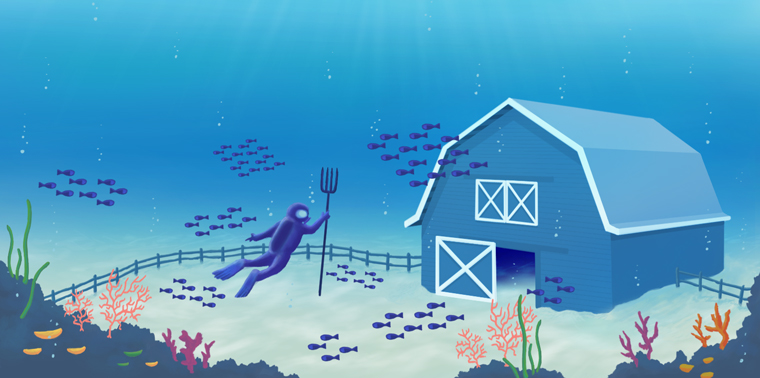September 11, 2017 — Eleven thousand years ago, the invention of agriculture made stable food supplies possible for the first time. In a relative blink of the eye, farming whisked aside 2 million years of hunting and gathering.
Since then, agriculture has met ever-expanding demands for food with innovations like selective breeding, draft animals, mechanization, hybrid seeds and artificial fertilizer. Progress continues to this day: In the United States, farmers raise two and a half times as much food today as they did in 1950, and they’re doing it with no increase in costs of labor and inputs such as seeds, fertilizers and chemicals.
Impressive as that is, it may not be enough. Expected global population and demographic changes mean we need to double (or nearly double) our food production by the 2040s. But agriculture already uses 38 percent of the world’s land, and there’s no way to increase that meaningfully, much less double it, without massive deforestation. We need to do more with less, but how?
One solution is aquaculture, or fish farming. Among the oldest ways of producing food, aquaculture is also one of the most efficient — and, I contend, the best tool we have for feeding an estimated 9 billion people by the early 2040s. In terms of their environmental footprint (finprint?) fish easily outcompete chicken, pork and beef. Here’s why.
Why Cows Can’t Compete
Resource requirements for food animals depend on 1) the amount of corn, soy and other crops we produce to feed them and 2) how efficiently they use their feed. It takes about 2 pounds (1 kilogram) of feed to produce a pound (0.5 kilograms) of chicken, 4.5 pounds (2 kilograms) to raise a pound (0.5 kilograms) of a hog and 9 pounds (4 kilograms) for beef cattle.
But we don’t eat cows. We eat steaks and burgers, and only 40 percent of the weight of cattle at the farm ends up on a plate. Chicken and pigs do better. We eat 58 percent of a chicken and 56 percent of a pig.
Fish have decided advantages over land animals. Fish have decided advantages over land animals. Because they live in a weightless environment, they spend less of their food energy making bones that we don’t eat and more making muscles that we do. That means we can eat more of a fish than we do with a land animal. And they’re cold-blooded so they don’t have to use part of the food we feed them to maintain their body temperature, as warm-blooded food animals do — boosting their feed-to-food conversation efficiency. By contrast, it takes about 1.3 pounds (0.6 kilograms) of feed to raise a pound of fish. And, with salmon, for instance, we eat 64 percent of the fish.
A Thought Experiment
Imagine that without changing the total amount of animal protein Americans eat, we shift the composition away from land animals to consumption of sea creatures by reducing annual consumption of chicken, pork and beef by 10 pounds (5 kilograms) each and increasing fish on our menus by 30 pounds (14 kilograms) per year.
Because fish production is so much more efficient than production of land animals, we could produce an additional 44 pounds (20 kilograms) of fish per capita for over a billion people without producing any more feed than we do currently.
There is a caveat here: Many farmed fish today are fed fish meal and fish oil that come from fish captured from wild fisheries, and harvests of those fish are at their sustainable limits. However, changes are at hand.
Fish meal provides protein for fish diets, but there’s no reason protein must come from fish meal.Fish meal provides protein for fish diets, but there’s no reason protein must come from fish meal. For instance, soy meal and even insect larvae (see here and here) substitute well for fish meal. Using them instead of fish meal helps break aquaculture’s dependence on marine ingredients.
With fish oil, the story is different. Fish oil provides aquaculture diets with required long-chain omega-3 fatty acids. In the ocean, plankton make long-chain omega-3 oils that travel through the food web, eventually ending up in the fish rendered to make fish oil. The aquaculture industry is devoting large efforts to find land-based ways to replace fish oil in aquaculture diets. Algae (see here and here), yeast, and plants (see here and here) have all been successfully developed as sources of essential omega-3 oils. As their production increases, they will provide alternatives to the fish oil-based omega-3 oils in fish diets.
Another Thought Experiment
On its 822 square miles (2,129 square kilometers), Duplin County, North Carolina, produces more hogs than any other county in the country, roughly 2 million per year. This adds up to 280 million pounds (127 million kilograms) of meat. To produce as much animal-derived food as Duplin’s hogs, what size fish farm must you build?
We’ll make our hypothetical farm 15 meters (16.4 yards) deep. Within it, fish will never exceed a density in their pens greater than 10 kilograms (22 pounds) per metric ton (20 pounds per ton) of water — a relatively low density in fish-farming terms.
Lastly, to be very conservative, let’s assume we eat only 50 percent of each fish we grow (the rest being fins, bones, intestines and other less palatable parts).
Make more. Use less. Aquaculture checks both boxes — exactly what we know agriculture of the future must do.Our hypothetical farm fares well. To match the hog production on the 822 square miles (2,130 square kilometers) of Duplin County, our fish farm requires a bit less than nine-tenths of a square mile (2.3 square kilometers) on the ocean surface. And that’s just a microfraction of the ocean suited for fish farming.
The comparison is imperfect; not all of Duplin county is hog farms because air and water quality issues preclude increased production. In other words, Duplin County’s hog production has hit its upper limit; fish farming is far, far from doing the same.
Checking Both Boxes
Make more. Use less. Aquaculture checks both boxes — exactly what we know agriculture of the future must do.
We need more sustainably raised and nutritious food. Aquaculture clearly can provide it. And aquaculture is the fastest growing segment of agriculture. It is poised to contribute meaningfully to our future food needs.
Of course, aquaculture isn’t the single answer to our future food needs. There is no single answer to how we construct our future food supply. But aquaculture changes a very somber outlook to one that fairly oozes hopefulness. ![]()
Editor’s note: The views expressed here are those of the author and not necessarily of Ensia.
Ensia shares solutions-focused stories free of charge through our online magazine and partner media. That means audiences around the world have ready access to stories that can — and do — help them shape a better future. If you value our work, please show your support today.
Yes, I'll support Ensia!

All of the nutrients we need to thrive can be obtained more healthfully, humanely, and environmentally responsibly from plant sources.
If you want to promote aquaculture, promote plant aquaculture. Now that is promising, very!
Nice article and i do support the cause. We should rely more on sustainable Aquaculture
However we have to keep the oceans clean and also with the right temperature otherwise it's gonna be problems in the quality of the fish.
I support the reduction of animal farming, the demand for meat will in the long run be declining and we do not need animal protein in our diet.
https://www.seattletimes.com/life/food-drink/just-gross-seattle-chefs-tell-the-governor-what-they-think-about-fish-farms-in-washington-waters/
The article also espouses soy as an alternative to fish meal...not a good resource for all sorts of environmental and health reasons. Also, I don't want to eat soy-fed fish. And while tank-based aquaculture may not pose a risk to wild fish populations, the practice is currently unsustainable economically and can require large amounts of water.
Aquaculture is not a panacea.
Dr. Nielson is right - there are environmental justice, food security and other issues in the seafood system that the author misses completely.
That the author cites agriculture having increased its yield w/o increasing labor costs as a positive is a big red flag. We do not pay the true costs of food in our country. Most farmers barely make ends meet and have to hire undocumented laborers b/c few documented laborers will do the labor for the pay. And if/when farm labor wages increase, so will the cost of food.
Aquaculture is rife with environmental issues. That it may have fewer environmental issues and higher yield than land farming is a definite bonus. But it doesn't mean its a clean industry. It doesn't mean that it doesn't harm our wild-capture fishermen.
Yes, research environmental justice ocean grabbing if you truly want to know more about the issues. This article is only a cursory look at aquaculture and doesn't do the full issues justice.